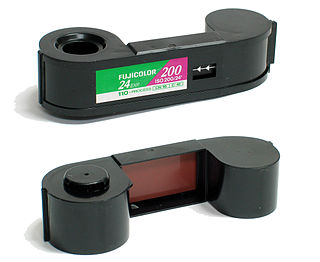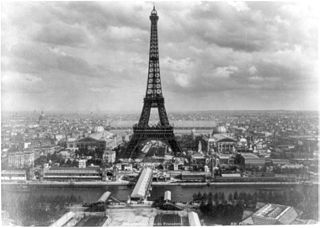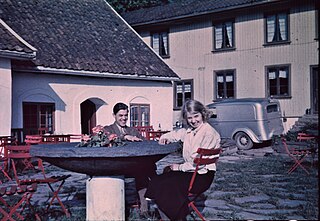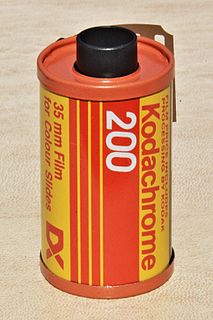The following list comprises significant milestones in the development of photography technology.

110 is a cartridge-based film format used in still photography. It was introduced by Kodak in 1972. 110 is essentially a miniaturized version of Kodak's earlier 126 film format. Each frame is 13 mm × 17 mm, with one registration hole. Cartridges with 12, 20, or 24 frames are available on-line. Production variations sometimes have allowed for an additional image.

Kodachrome is the brand name for a color reversal film introduced by Eastman Kodak in 1935. It was one of the first successful color materials and was used for both cinematography and still photography. For many years Kodachrome was widely used for professional color photography, especially for images intended for publication in print media.
Photographic processing or photographic development is the chemical means by which photographic film or paper is treated after photographic exposure to produce a negative or positive image. Photographic processing transforms the latent image into a visible image, makes this permanent and renders it insensitive to light.

Kodachrome Basin is a state park of Utah, United States. It is situated 5,800 feet (1,767.8 m) above sea level, 12 miles (19 km) south of Utah Route 12, and 20 miles (32 km) southeast of Bryce Canyon National Park. It is accessible from the north from Cannonville by a paved road and from the south by Road 400, a dirt road from the Page, Arizona area to Cannonville, passable for most vehicles in dry conditions. A longer but paved route to Tropic from the south is also available via US-89 and SR-12.

A monochromic image is composed of one color. The term monochrome comes from Ancient Greek μόνος (mónos) 'one', and χρῶμα (khrôma) 'color'.

In photography, reversal film or slide film is a type of photographic film that produces a positive image on a transparent base. Instead of negatives and prints, reversal film is processed to produce transparencies or diapositives. Reversal film is produced in various sizes, from 35 mm to roll film to 8×10 inch sheet film.

Color photography is photography that uses media capable of capturing and reproducing colors. By contrast, black-and-white or gray-monochrome photography records only a single channel of luminance (brightness) and uses media capable only of showing shades of gray.

Velvia is a brand of daylight-balanced color reversal film produced by the Japanese company Fujifilm. The name is a portmanteau of "Velvet Media", a reference to its smooth image structure. The original incarnation of the film was called "Velvia for Professionals", known as RVP, a classification code meaning "Reversal/Velvia/Professional series". It is known for its extremely high level of color saturation and image quality.

Agfacolor was the name of a series of color film products made by Agfa of Germany. The first Agfacolor, introduced in 1932, was a film-based version of their Agfa-Farbenplatte, a "screen plate" product similar to the French Autochrome. In late 1936, Agfa introduced Agfacolor Neu, a pioneering color film of the general type still in use today. The new Agfacolor was originally a reversal film used for making "slides", home movies and short documentaries. By 1939, it had also been adapted into a negative film and a print film for use by the German motion picture industry. After World War II, the Agfacolor brand was applied to several varieties of color negative film for still photography, in which the negatives were used to make color prints on paper. The reversal film was then marketed as Agfachrome. These films use Color Developing Agent 1 in their color developer.
Leopold Godowsky Jr. was an American violinist and chemist, who together with Leopold Mannes created the first practical color transparency film, Kodachrome.

Ektachrome is a brand name owned by Kodak for a range of transparency, still, and motion picture films previously available in many formats, including 35 mm and sheet sizes to 11 × 14 inch size. Ektachrome has a distinctive look that became familiar to many readers of National Geographic, which used it extensively for color photographs for decades in settings where Kodachrome was too slow. In terms of reciprocity characteristics, Ektachrome is stable at shutter speeds between ten seconds and 1/10,000 of a second.
Color prints have been developed since their beginnings in 1935 with Eastman Kodak’s Company’s Kodachrome film, as well in 1936 with Agfa Company’s Agfacolor film. Color print film is the most common type of photographic film in consumer use. Print film produces a negative image when it is developed, requiring it to be reversed again when it is printed onto photographic paper.

"Kodachrome" is a song by the American singer-songwriter Paul Simon. It was the lead single from his third studio album, There Goes Rhymin' Simon (1973), released on Columbia Records. The song is named after Kodak's now-discontinued reversal film brand Kodachrome.

K-14 was the most recent version of the developing process for Kodak's Kodachrome transparency film before its discontinuation. It superseded previous versions of the Kodachrome process used with older films.
Leopold Damrosch Mannes was an American musician, who, together with Leopold Godowsky Jr., created the first practical color transparency film, Kodachrome.

In still photography, Kodak's Kodacolor brand has been associated with various color negative films since 1942. Kodak claims that Kodacolor was "the world's first true color negative film". More accurately, it was the first color negative film intended for making paper prints: in 1939, Agfa had introduced a 35 mm Agfacolor negative film for use by the German motion picture industry, in which the negative was used only for making positive projection prints on 35 mm film. There have been several varieties of Kodacolor negative film, including Kodacolor-X, Kodacolor VR and Kodacolor Gold.
Dwayne's Photo is a film processing facility in Parsons, Kansas founded in 1956. It processes film, slides and certain movie films, and offers photo services.











